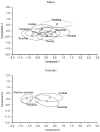Sport Activity Load and Skeletomuscular Robustness in Elite Youth Athletes
- PMID: 35564478
- PMCID: PMC9104919
- DOI: 10.3390/ijerph19095083
Sport Activity Load and Skeletomuscular Robustness in Elite Youth Athletes
Abstract
In an earlier report, bone mineral reference values for young athletes were developed. This study addressed variations in bone mineral parameters of young athletes participating in sports with different mechanical loads. The bone mineral status of 1793 male and female athletes, 11 to 20 years of age, in several sports was measured with DEXA. Specific bone mineral parameters were converted to z-scores relative to age- and sex-specific reference values specified by the DEXA software. Z-score profiles and principal components analyses were used to identify body structural components in the young athletes and to evaluate the associations between the identified component and type of sport defined by mechanical load. A unique skeletomuscular robusticity of male wrestlers, pentathletes, and cyclists was noted: wrestlers had significantly more developed skeletomuscular robusticity and bone mineral density compared to the age-group average among elite athletes, while pentathletes and cyclists had lower bone mineral parameters than the age-group references among elite athletes. Among female athletes, bone mineral parameters of both the trunk and extremities of rhythmic gymnasts and pentathletes were significantly lower compared to the age-group means for elite athletes. The bone mineral development of elite young athletes varies with the impact forces associated with their respective sports. The skeletal development of cyclists, pentathletes, and rhythmic gymnasts should be monitored regularly as their bone development lags behind that of their athlete peers and the reference for the general population.
Keywords: DEXA; bone mineral; elite athletes; skeletomuscular robusticity.
Conflict of interest statement
The authors declare no conflict of interest.
Figures














Similar articles
-
Bone Mineral Reference Values for Athletes 11 to 20 Years of Age.Int J Environ Res Public Health. 2020 Jul 8;17(14):4930. doi: 10.3390/ijerph17144930. Int J Environ Res Public Health. 2020. PMID: 32650565 Free PMC article.
-
Peripubertal female athletes in high-impact sports show improved bone mass acquisition and bone geometry.Metabolism. 2013 Aug;62(8):1088-98. doi: 10.1016/j.metabol.2012.11.010. Epub 2013 Mar 11. Metabolism. 2013. PMID: 23490587
-
A comparison of bone mineral density in adolescent swimmers, pentathletes and figure skaters.Turk J Pediatr. 2019;61(6):831-838. doi: 10.24953/turkjped.2019.06.002. Turk J Pediatr. 2019. PMID: 32134575
-
Health Effects of Wrist-Loading Sports During Youth: A Systematic Literature Review.J Phys Act Health. 2018 Sep 1;15(9):708-720. doi: 10.1123/jpah.2017-0328. Epub 2018 May 9. J Phys Act Health. 2018. PMID: 29741447
-
Influence of sports participation on bone health in the young athlete: a review of the literature.PM R. 2011 Sep;3(9):861-7. doi: 10.1016/j.pmrj.2011.05.019. PM R. 2011. PMID: 21944303 Review.
Cited by
-
Mental Health Among Elite Youth Athletes: A Narrative Overview to Advance Research and Practice.Sports Health. 2024 Mar-Apr;16(2):166-176. doi: 10.1177/19417381231219230. Epub 2024 Jan 3. Sports Health. 2024. PMID: 38173251 Free PMC article. Review.
-
High prevalence of stress fractures and long-term amenorrhoea in high endurance female athletes: The misleading lack of correlation with bone mineral density.J Orthop. 2024 Apr 16;55:109-113. doi: 10.1016/j.jor.2024.04.015. eCollection 2024 Sep. J Orthop. 2024. PMID: 38681828 Free PMC article.
-
Low Cognitive Function Is Strongly Associated with The Intake of EPA and DHA in Adolescent Female Football Players in North Sumatra, Indonesia.J Multidiscip Healthc. 2025 Apr 8;18:1959-1968. doi: 10.2147/JMDH.S512737. eCollection 2025. J Multidiscip Healthc. 2025. PMID: 40224906 Free PMC article.
References
-
- Nelson M.E., Rejeski W.J., Blair S.N., Duncan P.W., Judge J.O., King A.C., Macera C.A., Castaneda-Sceppa C. Physical activity and public health in older adults: Recommendation from the American College of Sports Medicine and the American Heart Association. Circulation. 2007;116:1094–1105. doi: 10.1249/mss.0b013e3180616aa2. - DOI - PubMed
MeSH terms
Substances
LinkOut - more resources
Full Text Sources

